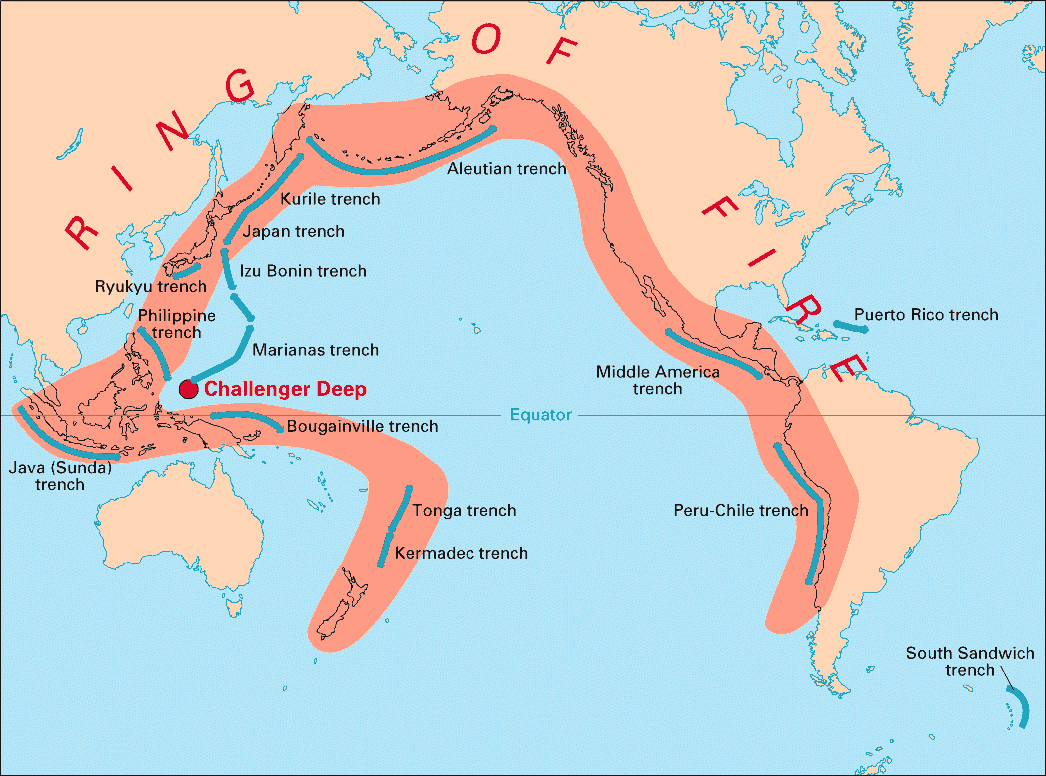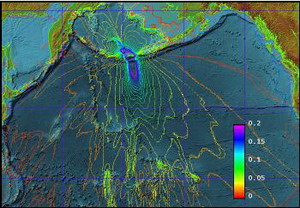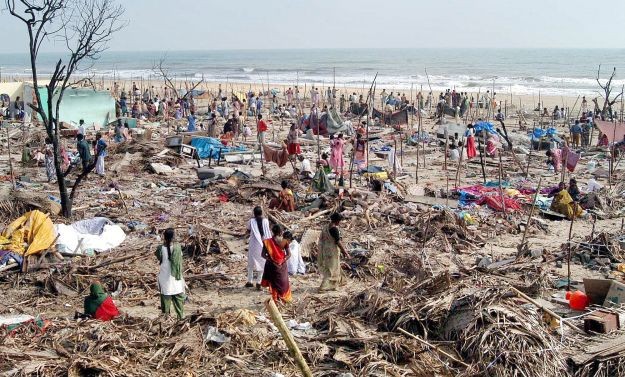Terrifying, Terrorizing Tsunamis

The origin of the word “tsunami” is from Japan, meaning harbor wave. Did you know that a tsunami wave can travel more than 500 miles per hour? The enormous wave starts as a disturbance in the ocean’s floor, and as it gradually goes inland it starts to go faster and builds up energy, and once it reaches the shore it creates a high-speed massive wave. Some waves can reach as tall as a ten story building! Natural disasters are an exhilarating phenomenon, ranging from tornadoes, to hurricanes, to earthquakes, they are all scary. That is why I like Colorado, there is not enough water for hurricanes or tsunamis, and the mountains create a protective circle that prevent tornados from coming in too often. The natural disaster that freaks me out the most is tsunamis. It is frightening how many stories that I have heard about tsunamis, and the amount of damage they have created.
The Ring of Fire
Our world is made up of 71% water, in that there are five different oceans- the Pacific Ocean being the largest. The Pacific Ocean is quite a remarkable body of water. Even though its name means the ‘peaceful sea’, the Pacific Ocean is the host of the Ring of Fire. The Ring of Fire is a region in the Pacific Ocean where a large amount of earthquakes occur in the oceans basin. The combination of earthquakes and a large body of water results in many tsunamis. In the past ten years there have been 22 major tsunamis- all in the Ring of Fire. The reason why 80% of all tsunamis happen in the Ring of Fire is the large amount of tectonic change. The increased amount of tectonic movement results in an increased probability of an earthquake.
The most recent earthquake was on the coast of Japan. This December, when the Pacific and Philippine plates clashed together they produced a 7.4 earthquake. The earthquake sent the Pacific Tsunami Warning Center in a race to get the people of the Bonin Islands evacuated out of their homes because of the great risk of a tsunami in their area. This is shows us that scientists and researchers’ still haven’t found a precise monitor that indicates when tsunamis are going to hit.

Forecast Modeling
Even though there isn’t an exact device that calculates when tsunamis are going to take place, scientists have invented different ways of predicting when a tsunami might occur. One way is called forecast modeling a tsunami. This is a great way to monitor the ocean’s waters; scientists place sensors on the ocean floor and when a particularly large amount of swelling or enlargement of water happens in a certain place-this could be an indication of a tsunami. The ocean sensors are extremely responsive and when there is the most miniscule amount of bulge in the water, the sensors send the information to a buoy near the shore. Then the buoy sends the information to a satellite in space. Now scientists are able to monitor the information from the sensors in the ocean.
This is a great way to predict when tsunamis might occur because the sensors send the information sometimes hours before the tsunami could occur. The early warning gives time for the people to evacuate. Forecast Modeling is a useful tool to help measure the swelling of the water. However, not all of the swelling in the ocean causes a tsunami. The con of this mechanism is that it can’t decipher between real swelling from a tsunami or just a lot of water in an area. This results in lot of false-alarms. Although we don’t have a very exact and precise way of monitoring the earth’s waters, at least this is a start to the research of finding an accurate way of predicting when tsunamis are going to occur.

Tsunami Destruction
The destruction from a tsunami is mind boggling. The results of these natural disasters vary from hurtling boats inland to ripping off the roofs of houses. According to National Geographic the worst tsunami in history held enough energy equivalent to 23,000 atomic bombs! In Hiroshima, only one atomic bomb was dropped and it destroyed a whole city-imagine what 23,000 atomic bombs could do. Currently we don’t have a precise monitor that warns us when a tsunami is about to hit, what we do have is the ability to think outside the box in order to protect us from the strong waves.
After a mammoth size tsunami in Sir Lanka, universities, governments, and people got together and decided to create a safe house that is very resistant to a tsunami’s mega force. The Safe house is special because of four major components; a concrete core structure, traditional bamboo woven ventilation, a roof structure made up of coconut wood, and finally a raised platform to help the water drain from the house. Universities created these houses out of material that is cheap and easy to get. With these Safe houses not as many people will be on the streets after a tsunami.
 |
| This is a regular house, and with the results from a tsunami are quite bad. |
 |
| This is an example of a Safe (r) house, and with the impact of a tsunami the house it still standing. |
Many Different Impacts

The destruction of a tsunami doesn’t just affect the physical appearance of the country, but also the economy, the society, the culture, and the environment. For countries around the coast, marine fisheries have a big impact on the economy. During a tsunami the strong waves severely damage the boats, gear and the fish itself. Studies show that after the tsunami the fish can be half its original size! After a tsunami in Thailand almost 80% of the counties fishing boats were completely destroyed.
Another outcome from tsunamis is the decrease of tourism. Many times people go to countries because of the beautiful beaches and waters. Tsunamis have a great impact on tourism. After a tsunami hits a city, I am not sure if many people will be too desperate to go to that country. In Thailand after a tsunami, twenty percent of the coral reefs were completely destroyed, and 60% of the coral reefs were knocked over. If this was not handled quickly forty percent of the coral would not have survived. The tsunami left Thailand’s shores cluttered with strayed debris of various parts of cars, boats, and roofs. The government is also affected from tsunamis. Think of when you are desperately trying to clean up your room before your mom comes home, and the only thing that you are thinking of is trying to clean up your room. This is what happens to a government when a natural disaster occurs; everyone’s so busy trying to clean up everything they don’t think of much else. Once a government is only thinking of one thing, they become unstable with things they need to focus on.
Tsunami Warning Systems
When an unknown tsunami is about to hit, it is essential to have some sort of warning system. Warning systems help prevent the destruction of buildings and the loss of life. When a tsunami is detected various alarms go off warning people about the tsunami. There are two types of warnings systems, the Regional Warning System and the International Warning System. The Regional Warning System uses local seismic data to decide whether a tsunami is going to occur. The Regional Warning System alerts people in the local area with sirens. The problem with these warning systems (just like the forecast modeling system), a lot of false-alarms can occur. The International Warning System uses data from many other countries to determine if a tsunami is going to occur. Both of these systems are extremely important to have in order to keep everyone safe.
Being Safe in a Tsunami
When you put all of this together, the most important part when in a tsunami is being safe. Here are some tips of being safe in a tsunami.
1. Move to a higher ground immediately.
2. When traveling to a higher ground it is recommended to not use a vehicle, going on foot is a lot easier.
3. If it is not possible to go to a higher ground go inland, as far away from the coast as you can.
4. If it is not possible to go inland for to a higher ground, go on to the roof of a concrete building. Concrete is the sturdiest material that is resistant when under a force of a tsunami.
5. If possible stay tuned to the radio for further information about the tsunami.
6. Remember, go to the higher ground!
Works Cited
CNN Wire Staff. "Quake near Japanese Islands Triggers Tsunami Warning - CNN.com." CNN.com International - Breaking, World, Business, Sports, Entertainment and Video News. 21 Dec. 2010. Web. 18 Feb. 2011. .
CSA. "Tsunamis and the International Response: Economic, Social and Environmental Dimensions." CSA. 2005. Web. 18 Feb. 2011. .
Gardier, Lisa. "Tsunami Safety Facts." Web log post. Windows to the Universe. Winter 2005. Web. 18 Feb. 2011. .
INCOIS. "Tsunami Modeling." Tusunami Modeling. Web. 18 Feb. 2011. .
National Geographic. "Tsunami Facts, Tsunami Information, Tsunami Videos, Tsunami Photos - National Geographic." Tsunami Facts, Tsunami Information, Tsunami Videos, Tsunami Photos - National Geographic. Environment Facts, Environment Science, Global Warming, Natural Disasters, Ecosystems, Green Living - National Geographic. Web. 18 Feb. 2011. .
NOAA. "Causes of Tsunamis." NOAA's National Weather Service. Web. 18 Feb. 2011. .
NOAA. "Tsunami Events." NOAA Center for Tsunami Research. Web. 18 Feb. 2011. .
NOAA. "Tsunami Modeling and Research." NOAA Center for Tsunami Research. Web. 18 Feb. 2011. .
"Safe(R) House | Open Architecture Network." Open Architecture Network | Helping Communities Sustainably Improve Living Conditions through Innovative Design and Construction. Web. 18 Feb. 2011. .
University of Cambridge. "Tsunami Thusyanthan." Model Testing of a Tsunami Safe (r) House. Web. .
USGS. "Earthquake Facts." U.S. Geological Survey Earthquake Hazards Program. Web. 18 Feb. 2011. .
Washington Edu. "The Tsunami Warning System." Editorial. Tsunami Warning System: 1-2. Earth and Space Sciences at the University of Washington. Web. 18 Feb. 2011. .
No comments:
Post a Comment